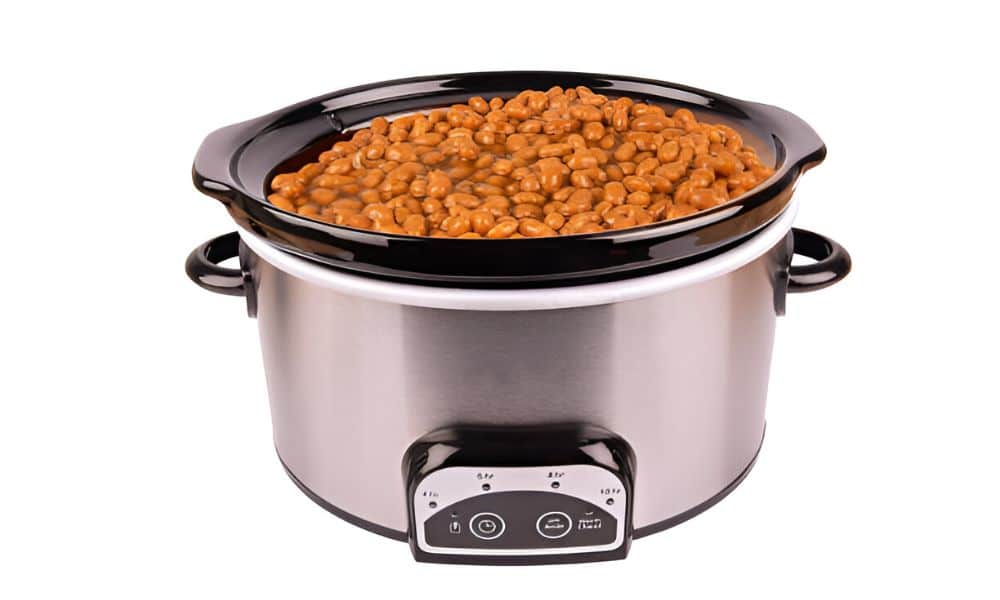Rain tapped my window. The old pot hummed on the counter. I set out to learn how to cook pinto beans in slow cooker the easy way. Years of home meals shaped a calm, sure path. I have tested soaked and no-soak paths across many pots. You will get soft beans, steady flavor, and low work. I share times, liquid, salt notes, and small tricks. Solo cooks, small homes, and busy days also get help. I note the Best Slow Cookers for One Person. Grab a bag, and let us cook a warm bowl tonight. Let us begin now.
What are pinto beans?
Pinto beans are classic pantry stars. The dry beans look tan with brown specks. After cooking they turn rosy tan. The taste is earthy and mild.
The texture feels creamy. Skins stay tender and thin. The center turns soft and rich. They hold shape, yet mash with ease.
A slow cooker suits them well. Gentle heat coaxes starch into silk. Aromatics melt into the pot and spread flavor through each bean. Hands-on time stays low while results shine.
The beans cost little and feed many. You get steady protein, fiber, and key minerals. A big batch stores well for days. Extra portions freeze flat for fast future meals.
What you need
Beans
- Use 1 pound dry pinto beans. Spread on a tray and sort out pebbles.
- Rinse under cool water in a colander. Shake off extra water.
- Soak is optional. A soak trims time and gives even texture.
Liquid
- Plan on 6 cups liquid per pound. Water keeps the taste clean.
- Broth adds depth; pick low sodium for balance.
- No-soak beans drink more liquid. Add 1 extra cup as needed.
Aromatics
- Onion, garlic, and a bay leaf form a warm base.
- Dice the onion. Smash the garlic. Keep the bay leaf whole.
- Add jalapeño or oregano for a gentle twist.
Seasoning
- Ground cumin and smoked paprika bring cozy notes.
- Black pepper adds lift.
- Add salt near the end. This keeps skins tender and centers creamy.
Fat options
- 1–2 tablespoons olive oil gives a lush broth.
- Butter adds a mellow round finish.
- Smoked meat scraps or a ham hock add deep, rustic flavor.
Tools
- Slow cooker, 4–6 qt for families or meal prep.
- Mini cooker, 1.5–3 qt for one-person meals; great for small batches.
- Colander, measuring cups and spoons, sturdy spoon, and a ladle.
- A kitchen scale helps with repeat results.
Soak or no soak
Soaking pulls water into each bean. Skins soften. Heat reaches the center with ease. The pot cooks even and smooth.
Soak also trims the clock. Low: 7–8 hours for soaked beans. No soak: 8–10 hours on Low. High: 3½–4½ hours soaked; 5–6 hours no soak.
Both paths work. The taste stays deep in each. Pick the track that fits your day. You will get tender beans either way.
Step-by-step: how to cook pinto beans in slow cooker
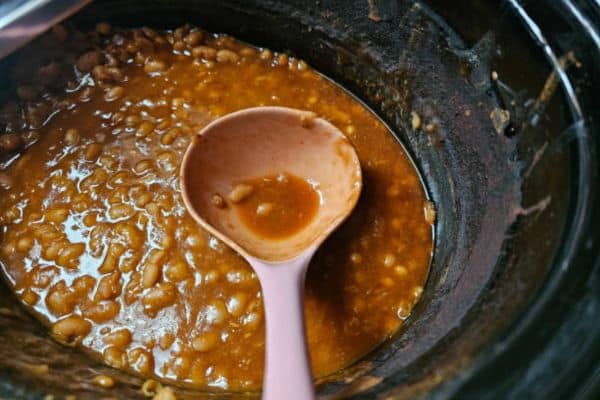
Here is my simple path to tender, creamy beans. It shows exactly how to cook with calm, clear steps.
01. Sort and rinse
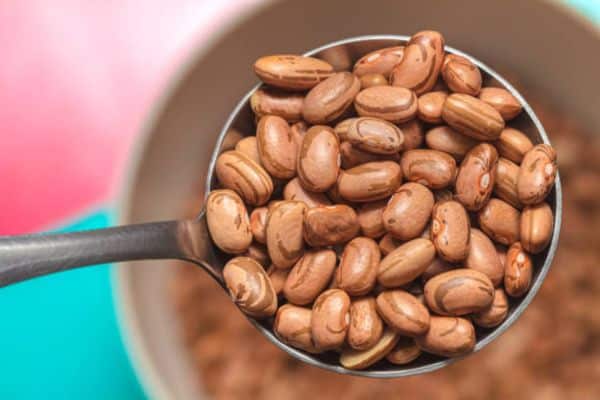
Spread the beans on a tray. Pick out pebbles or shriveled bits. Rinse under cool water in a colander.
02. Build flavour
Add oil to the slow cooker. Tip in onion, garlic, cumin, and paprika. Drop in a bay leaf. Stir to coat the aromatics.
03. Add beans and liquid
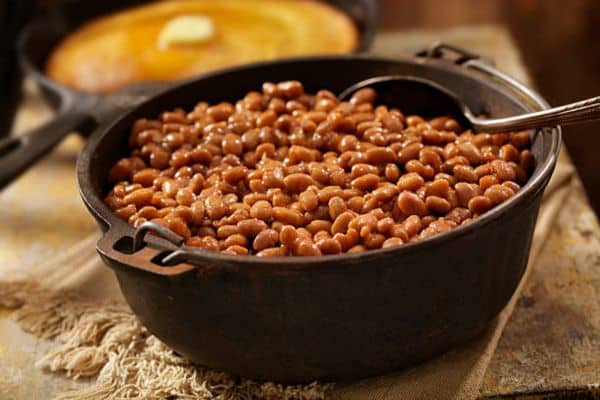
Pour in the beans. Add liquid to cover by about a finger. Use 6 cups for soaked beans. Use 7 cups for no-soak beans. Keep a little hot water nearby for top-ups.
04. Set and cook
Low: soaked 7–8 hours; no-soak 8–10 hours.
High: soaked 3.5–4.5 hours; no-soak 5–6 hours.
Lift the lid near the end. A bean should mash with light pressure.
05. Season to finish
Stir in salt near the end. Add a small splash of lime juice or vinegar for lift. Give the pot a gentle stir. Rest on Warm for 10 minutes.
06. Serve
Spoon into bowls. Add rice, tortillas, or cornbread. Try cilantro, scallions, sour cream, or a drizzle of olive oil.
Proven tips from my kitchen
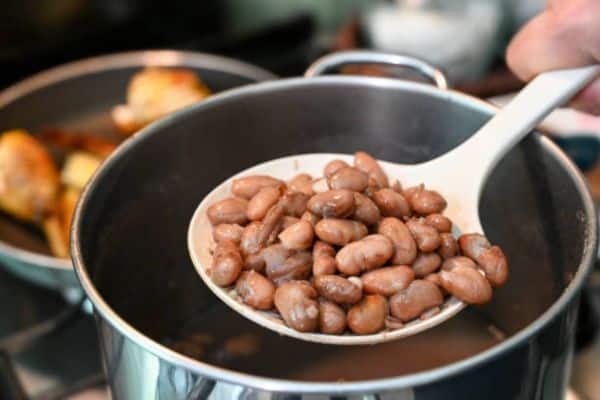
Buy fresh dry beans.
Old stock stays tough. Look for a recent pack date. Stores with fast turnover work best. Fresh beans cook even and turn creamy.
Keep the liquid steady.
The level should sit about a finger above the beans. Add hot water to hold that mark. Hot water keeps the heat stable. Cold water shocks the pot.
Add a little fat.
Olive oil, butter, or bacon drippings each add body. Fat carries spice and rounds sharp edges. Two tablespoons do the job. The broth turns lush and silky.
Stir with care near the end.
Early stirring breaks skins. Wait until the beans start to soften. Give one gentle sweep across the bottom. Use a wide spoon and a calm hand.
Let the pot rest on Warm.
Ten minutes is enough. Starch settles and thickens the broth. Flavors relax and blend. The bowl tastes fuller and smooth.
Finish with bright notes.
Tomato, lemon, or a splash of vinegar lifts the pot. Add near the end for a clear, clean pop. The beans stay tender. The flavor sings.
Flavour paths (easy swaps)
Smoky
Smoked paprika lays a warm base. Add bacon ends or a small ham hock. A pinch of cumin deepens the pot. Finish with a drop of molasses for round sweetness.
Bright herb
Oregano brings a clean lift. Add lemon zest to the pot. Fresh parsley at the end adds pop. A light squeeze of lemon wakes the bowl.
Mild heat
Stir in a chopped jalapeño. Add chili powder for a gentle glow. Lime juice at the end sharpens the edge. A dollop of sour cream cools the bite.
Vegan umami
Slide in a strip of kombu at the start. Fish it out before serving. Blend a spoon of miso into a ladle of hot broth, then stir back. A dash of soy sauce adds depth.
Garden mix
Add diced carrot and bell pepper at the start. Fold in baby spinach at the end. A dusting of nutmeg feels cozy. Fresh thyme leaves make the pot sing.
Serving ideas
Over rice with pickled onions
Spoon beans over hot rice. Add bright onions and a little brine. Finish with fresh herbs.
In warm tortillas with sour cream
Fill soft tortillas with beans. Add sour cream and crisp greens. Fold and serve right away.
With quinoa and roasted sweet potato
Layer quinoa in a bowl. Add beans and sweet potato cubes. Top with toasted seeds for crunch.
On toast with feta
Mash some beans till thick. Spread on warm toast. Crumble feta on top and add olive oil.
As a quick soup starter
Blend a cup of beans with hot broth. Pour back into the pot. Simmer to a smooth, light soup.
Storage, freezing, and reheating
Fridge time and best containers
Cool the pot fast. Spread beans in shallow containers. Use glass or sturdy plastic with tight lids. Chill for up to five days.
Freeze flat in bags; label dates
Scoop portions into quart bags. Press flat on a tray. Freeze, then stack to save space. Add a label with date, size, and flavor path.
Reheat with a splash of water; taste and tweak salt
Pour a portion into a pan. Add a splash of water or broth. Warm over medium heat to a gentle bubble. Taste and add a pinch of salt or a squeeze of lime.
Troubleshooting
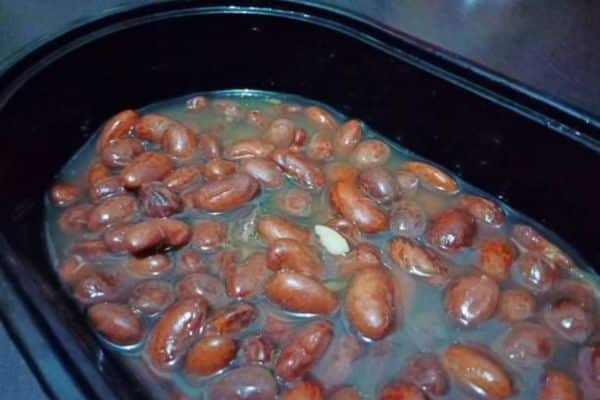
Beans still firm
Keep cooking in 30-minute steps. Add hot water to hold the level above the beans. Test a bean for an easy mash. Very old stock may need extra time.
Broth too thin
Ladle out a cup and mash the beans in it. Stir the mash back into the pot. Let the cooker run on High for 10–15 minutes. The broth will thicken and shine.
Flavor tastes flat
Add a pinch of salt and stir. Try a small splash of vinegar or lime. Rest the pot for five minutes. Taste again and adjust.
Skins split or mushy
Use Low heat for the full cook. Stir near the end only, and keep it gentle. Add salt late. Hold the liquid at a steady level above the beans.
Mini buying guide: Best Slow Cookers for One Person
Who benefits
Dorm rooms, studio flats, and shared kitchens. Solo cooks who love small, fresh batches. Busy pros who need set-and-forget meals.Best Slow Cookers for One Person. Parents who want a side dish pot beside the main cooker.
Right size
1.5–3 qt hits the sweet spot. A 1.5–2 qt pot makes two small bowls. A 3 qt pot makes extra for lunch. Compact size saves counter space.
Key features that help
A true Low setting with steady heat. Auto Keep-Warm for a safe hold. Locking lid for spill-free travel. Removable ceramic insert for easy clean. Clear glass lid to check progress. Simple dial controls that last.
Why this matters for beans
Small pots heat evenly with less waste. Low heat stays gentle on skins. Broth turns silky and rich. Portion control stays easy.
Safety and quality notes
Rinse beans well
Pour beans into a colander. Rinse under cool running water. Swirl with your hand to lift dust. Drain fully before loading the pot.
Clean tools and safe temps
Wash hands, boards, and knives before you start. Keep the cooker on Low or High, not Warm, for the full cook. Hold hot food above 60°C/140°F. Chill leftovers within two hours.
Add dairy at the end
Stir in sour cream, cheese, or milk near serving time. Early dairy can dull the simmer and split. Late dairy stays smooth and lush. Flavor stays bright and clean.
FAQs
Do I need to soak pinto beans?
Soaking is optional. It trims cook time and makes texture even. No-soak works great too. Pick the path that fits your day.
How much liquid should I use?
Use 6 cups liquid per pound for soaked beans. Use 7 cups for no-soak. Keep the level about a finger above the beans; top up with hot water as needed.
Can I add tomatoes?
Yes. Add tomatoes near the end for tender skins. A spoon of tomato paste or a half cup diced works well. Finish with a small splash of vinegar or lime for lift.
Conclusion
A slow cooker turns humble beans into a cozy bowl. The work stays light, the payoff stays big. Sort, rinse, keep the liquid a finger high. Salt late, rest the pot, and enjoy that silky broth.
You now have a steady plan that just works. Soaked or no soak, both paths lead to soft centers and tender skins. Pick a flavor path to suit your mood.


